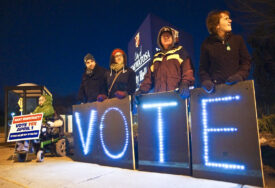Author’s note: This is an appendix to all my proportional representation articles that reference the “threshold of exclusion” in races for multiple seats in a district. Some readers want to know more about how I calculated those thresholds. This appendix explains.
A high enough threshold can exclude truly fringe voices from elected positions, but a too-high threshold can exclude all minorities.
A threshold of exclusion is the minimum number of voters who must vote for a candidate in order for that candidate to win—in other words, how big a group of voters has to be before it can win representation in the legislature, city council, school board, or whatever elected body is up for a vote. If a group of like-minded voters isn’t numerous enough to meet the threshold, other voters can exclude that group’s preferred candidate from office. A lower threshold of exclusion helps voters in the minority—whether ideological, racial, ethnic, religious, or other minority—because they are sure to win one seat if they pass it in their district; the majority will not be able to exclude them. The number must be well balanced, though: a high enough threshold can exclude truly fringe voices from elected positions, but a too-high threshold can exclude all minorities, meaning that the legislature, city council, or school board could exclude important community voices.
The threshold at work in single- and multi-winner races
In the single-winner races that Americans and Canadians are used to, the threshold of exclusion is 50 percent. If any candidate gets 50 percent of the vote plus one, he ensures that no other candidate is elected. This doesn’t mean that a candidate with less than 50 percent can never win; it means that, if the majority of voters prefer the same type of candidate, they can exclude all other types of candidates from winning even a minority of seats. The 50 percent threshold ensures that candidates from America’s two major parties have a near-stranglehold on elections and helps white male candidates (in the US and Canada both) win a disproportionate share of seats.
In contrast, multi-winner races with proportional methods have lower thresholds of exclusion. Voters in the minority, so long as they reach the threshold, can win a fairer share of seats in the legislature.
The Hagenbach-Bischoff quota
The threshold is the point at which a candidate has enough support that, mathematically, she must win a seat. The Hagenbach-Bischoff quota identifies the lowest possible mathematical threshold with this formula:
Number of Votes / (Number of seats + 1)
With just one seat up for contention, the threshold is 1 / (1+1) = 50 percent. In single-winner elections, once a candidate passes the 50 percent threshold, it is mathematically impossible for any other candidate to have more votes, so he must win the seat.
If three seats are available, however, the threshold is 1 / (3+1) = 25 percent. Here, if three candidates each receive more than 25 percent of the vote, it is mathematically impossible that any other candidate could have more than 25 percent, so those three candidates must each win a seat.
And so on, as spelled out in the following table:
| Number of seats in the pool | Hagenbach-Bischoff quota | A candidate must win at least: |
| 1 | 1/(1+1) | 50% |
| 2 | 1/(2+1) | 33.3% |
| 3 | 1/(3+1) | 25% |
| 4 | 1/(4+1) | 20% |
| 5 | 1/(5+1) | 16.7% |
| 6 | 1/(6+1) | 14.3% |
| 7 | 1/(7+1) | 12.5% |
| 8 | 1/(8+1) | 11.1% |
| 9 | 1/(9+1) | 10% |
In a three-winner race with 999 votes, the threshold is:
999 / (3+1) = 249.75, rounded = 250 votes
In a four-winner race with 999 votes, the threshold is:
999 / (4+1) = 199.8, rounded = 200 votes
The Droop Quota
The wording above, saying a candidate must win at least the Hagenbach-Bischoff quota, is inexact. To determine precisely when a candidate has received “at least” the threshold number of votes in a multi-winner ranked-choice race, election officials in Ireland and Australia use the Droop quota, which looks like this:
(Number of Votes / (Number of seats + 1)) + 1, rounded down to the nearest integer
In a three-winner race with 999 votes, the threshold is:
999 / (3+1) = 249.75 + 1 = 250.75, rounded down = 250 votes
In a four-winner race with 999 votes, the threshold is:
999 / (4+1) = 199.8 + 1 = 200.8, rounded down = 200 votes
The Hare quota
An older formula, the Hare quota, simply divides the votes by the number of seats:
Number of Votes / Number of seats
This yields a higher threshold of exclusion than the above two methods. For example, if three seats are available, the threshold is 1 / 3 = 33.3 percent. Each of the three candidates must receive fully one-third of the vote to win. This is more votes than you need to mathematically rule out other winners, as the Droop quota does.
In a three-winner race with 999 votes, the threshold is:
999 / 3 = 333 votes
In a four-winner race with 999 votes, the threshold is:
999 / 4 = 249.75, rounded = 250 votes
The Hare quota is less used than the Droop quota due to two inherent flaws: 1) because candidates need more votes to win a seat (fully one-third in a three winner race, instead of more than 25 percent in a Droop quota three-winner race), the Hare quota often requires more counting rounds than the Droop methods; and 2) if a majority of voters support a group of candidates, those candidates might win only a minority of seats (because the candidates together won, say 60 percent of the vote in a three-winner race but needed fully 66.7 percent to win two of the three seats). Therefore, I assume that proportional systems would not use the Hare quota.
Instead, I assume proportional systems would use the Droop quota. For simplicity, my articles say a candidate must exceed the Hagenbach-Bischoff threshold or win, for example, “at least” 25 percent of the vote in a three-winner race. The wording of “at least,” is inexact, but is meant to convey the Droop quota without spelling out the full formula. The threshold applies to multi-winner ranked-choice elections and also to limited and cumulative multi-winner elections where the minority of voters all cast all their votes for their one favorite candidate. If those voters reach the threshold of exclusion and vote together, their candidate cannot be excluded.











Richard Lung
Kristin, Since about 1980, the Electoral Reform Society dropped the final plus one vote from the Droop quota, because their ballot services chief, Maj Frank Britton found it never necessary. But it’s still called the Droop quota. Hence, 50 votes out of a hundred is the Droop quota for a single vacancy.
I expect that the ERS rulebook has long reflected this. Must check .
Richard Lung. “Democracy Science.”
Sara Wolf
It seems like this article is specifically looking at proportional representation for ranked ballots via IRV. It that right? What about cardinal (rating based) systems and their respective versions of PR? Do these stats still hold true or is that a whole other thing?
It seems like the fact that rating systems like Approval, Score, and STAR, which show support for multiple candidates at the same time, would change the dynamics of “minority factions” quite a bit even as single winner systems. Each of these also has a PR system that can use any of these quotas.
To illustrate: In a ranking system a Leftist voters vote will only support one candidate at a time as the ballot goes through the rounds. So a voter who supports a Green, a Progressive, and a Democrat to varying degrees wouldn’t necessarily show that they are represented by each. In PR this would mean that their vote is only re-weighted if one of these is elected but not if they have multiple candidates they support elected. Is that correct? In IRV generally some voters down-ballot rankings are all counted while for other voters some aren’t. How does that effect STV?
With a rating ballot a Leftist voter’s vote can support multiple candidates at the same time, often to varying degrees. So a voter who supports a Green, a Progressive, and a Democrat to varying degrees would have their vote re-weighted to a degree every time one of these was elected.
Does either type of system favor or disadvantage those who affiliate or support more candidates vs. less candidates?